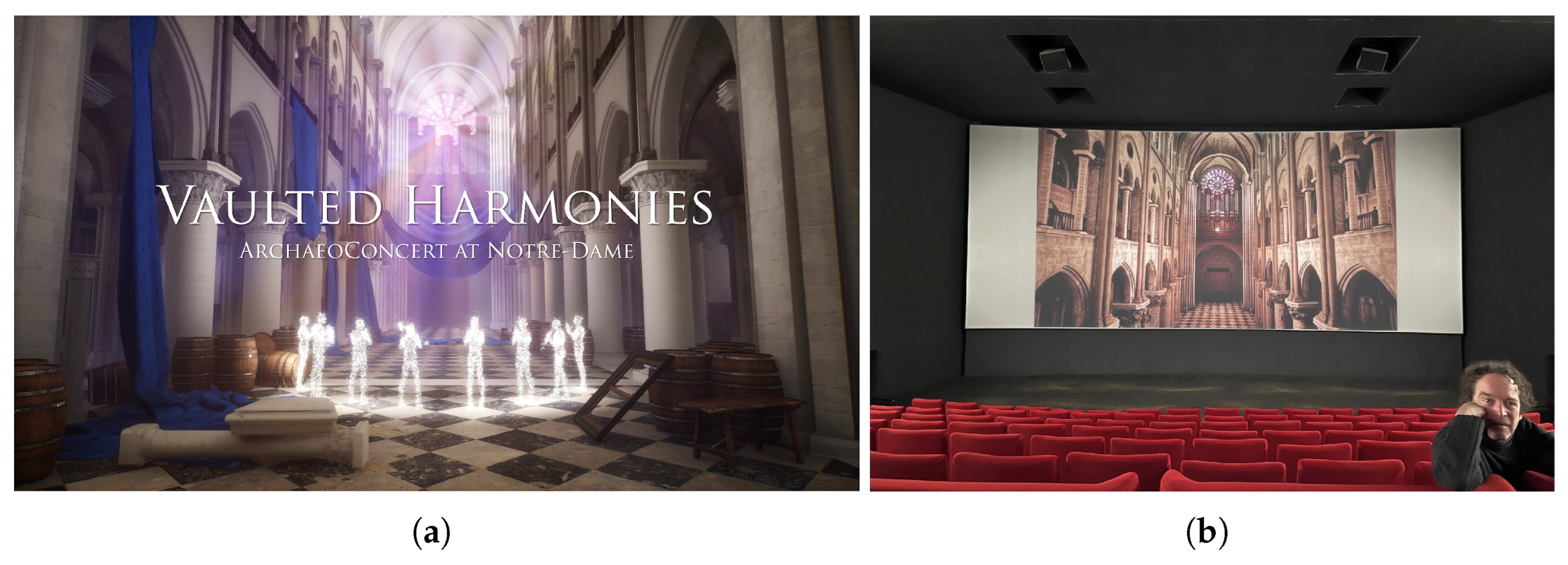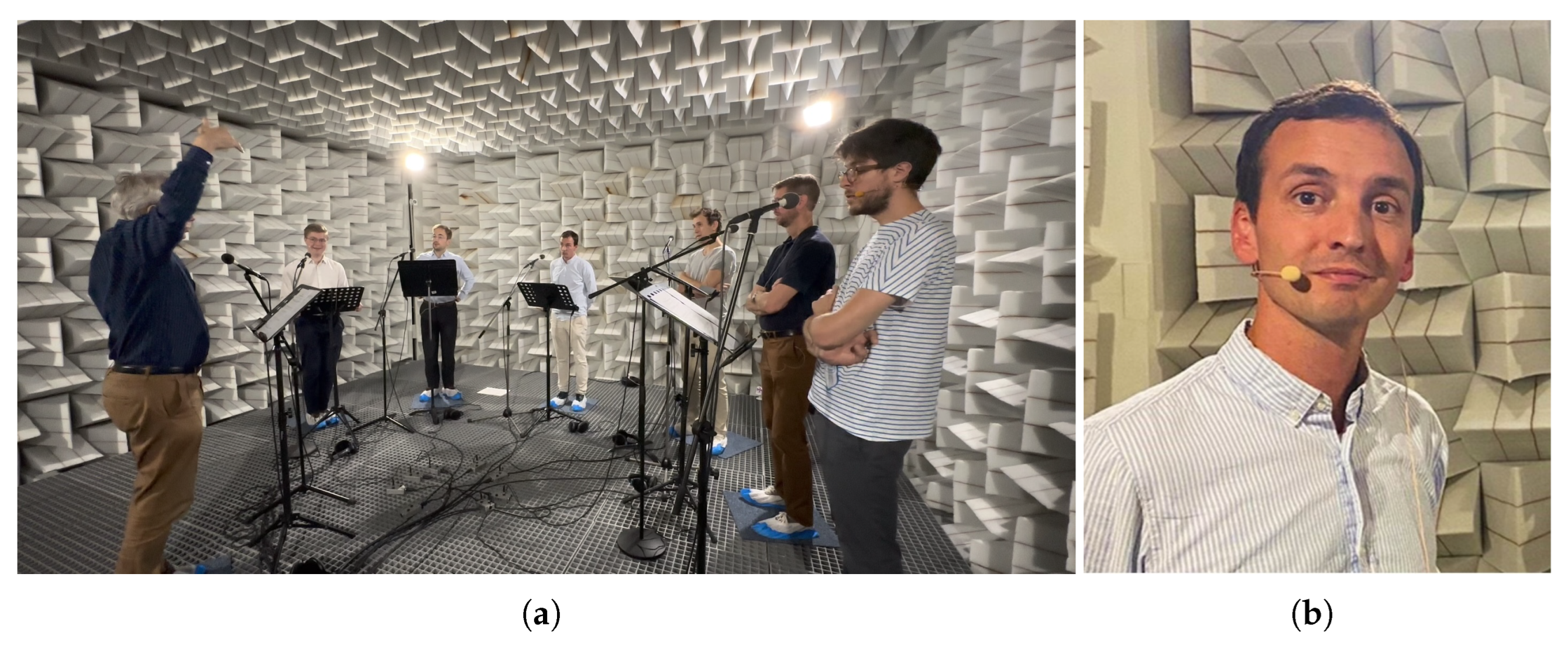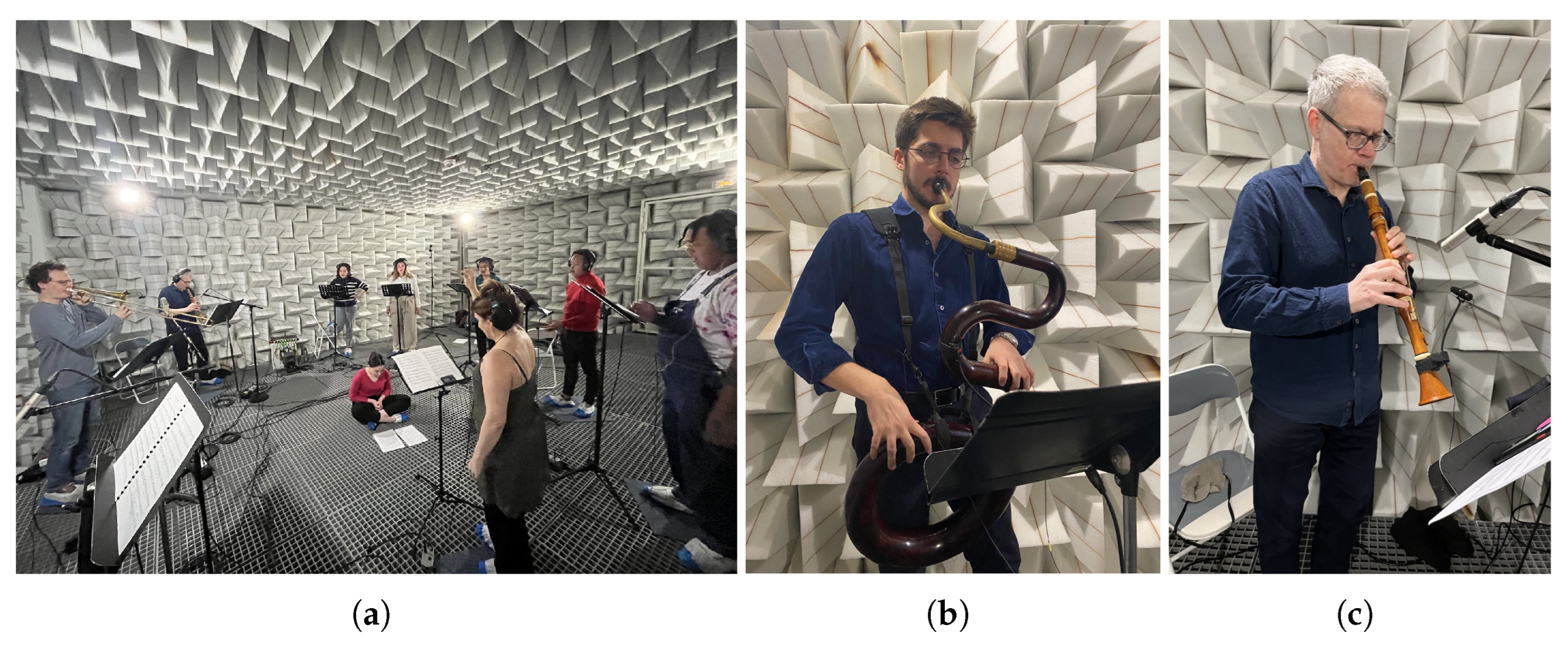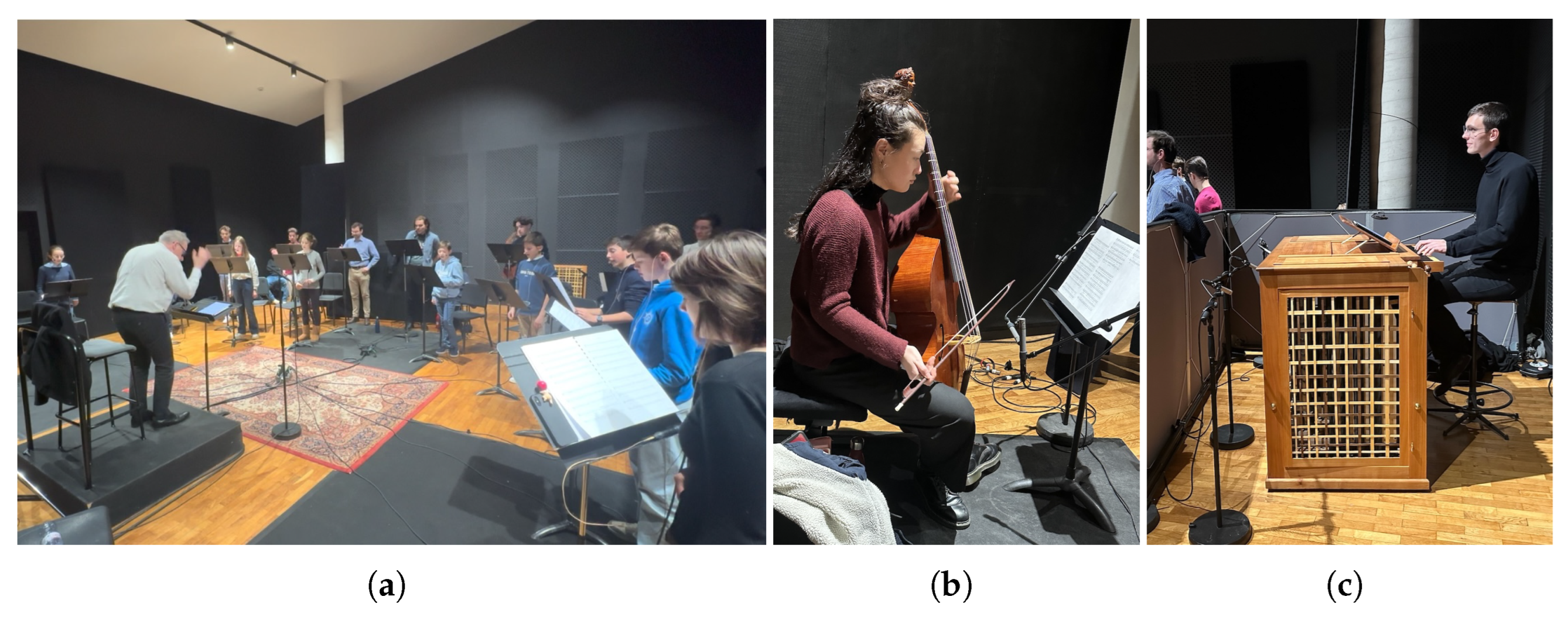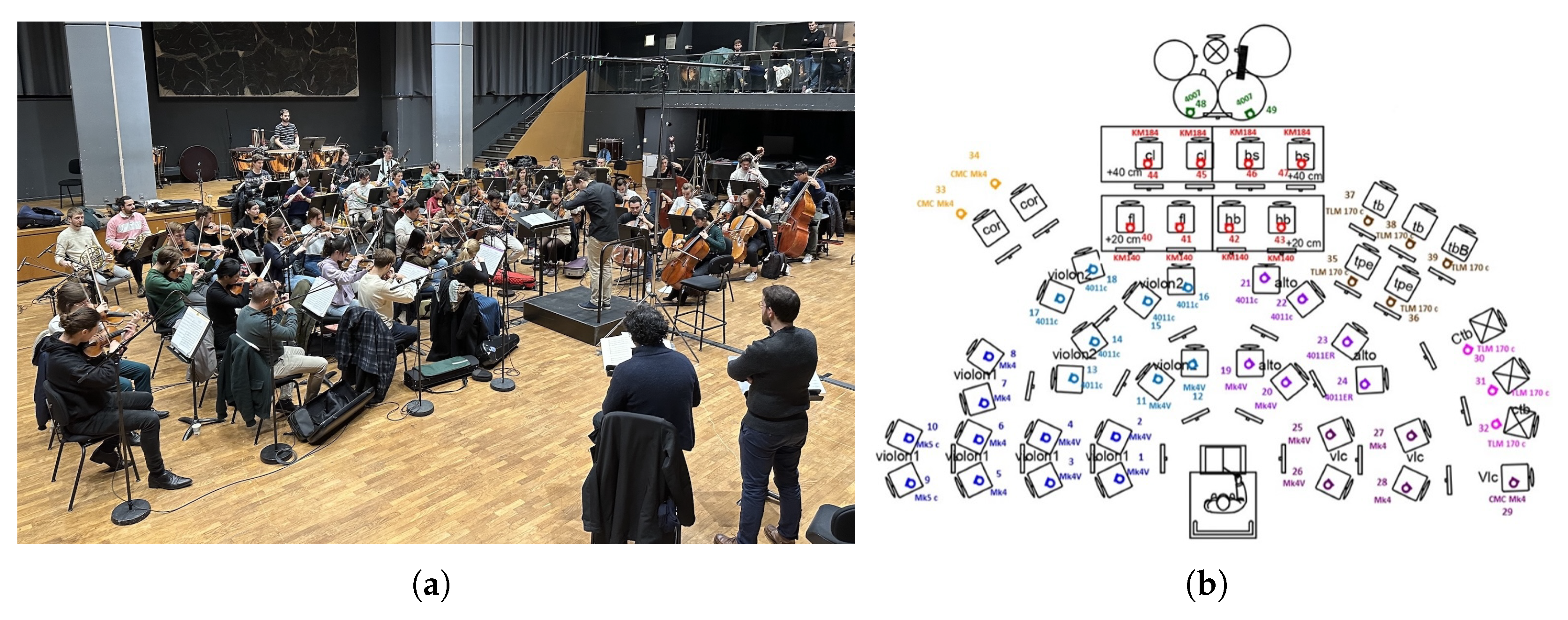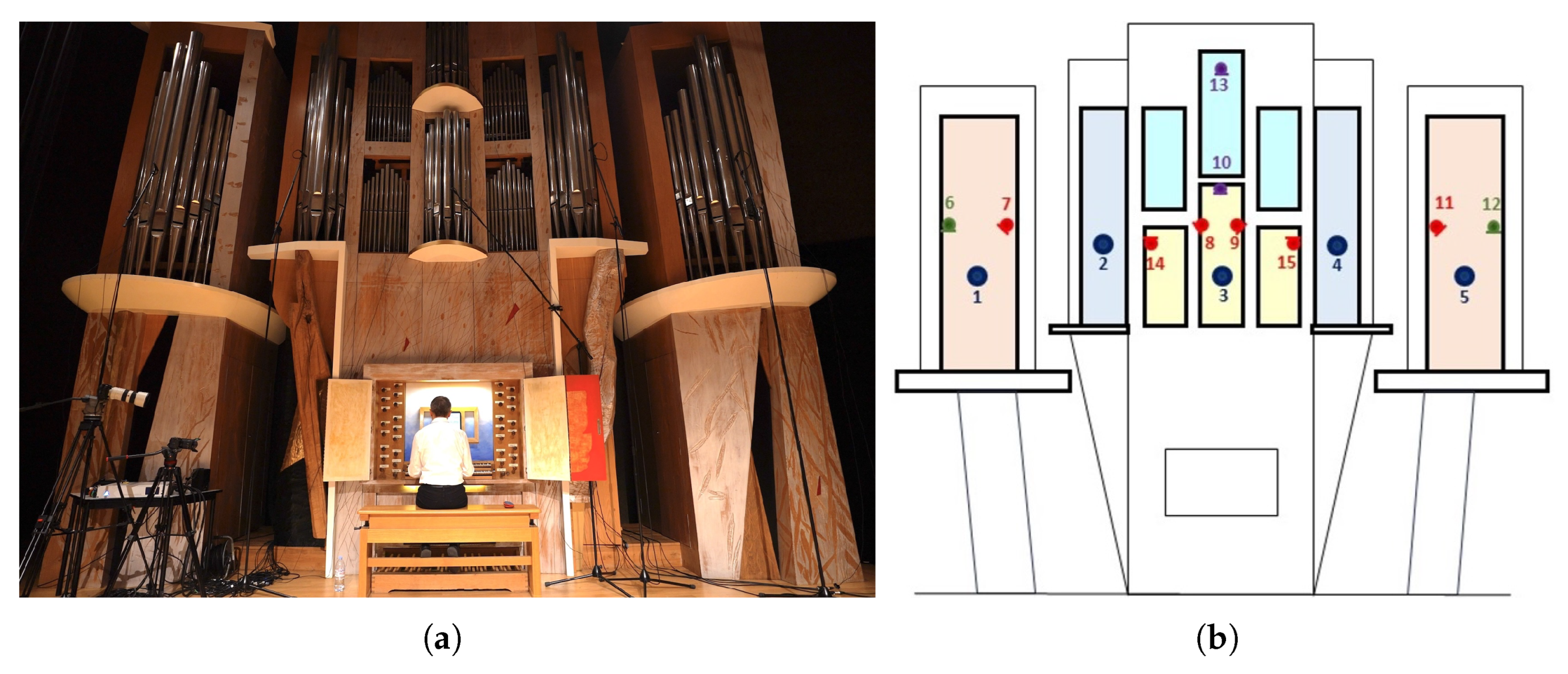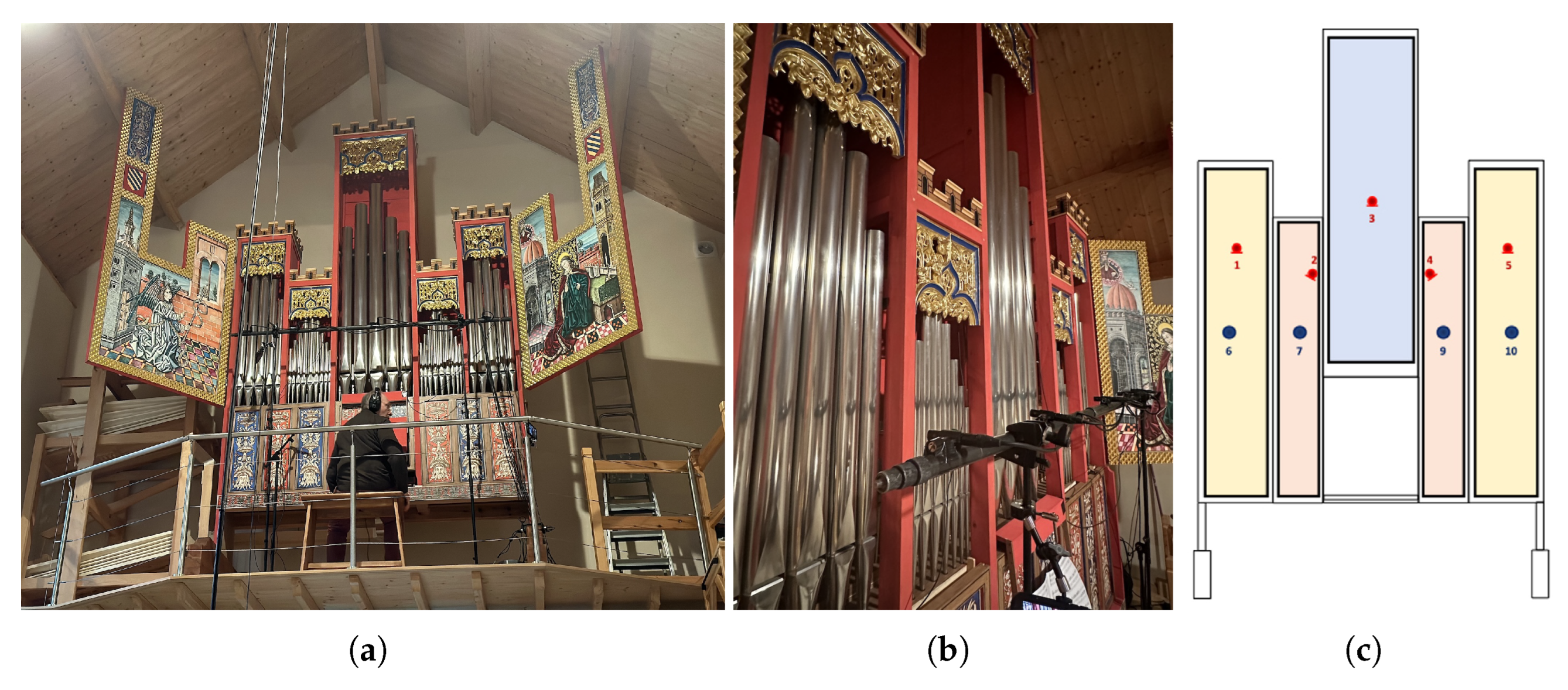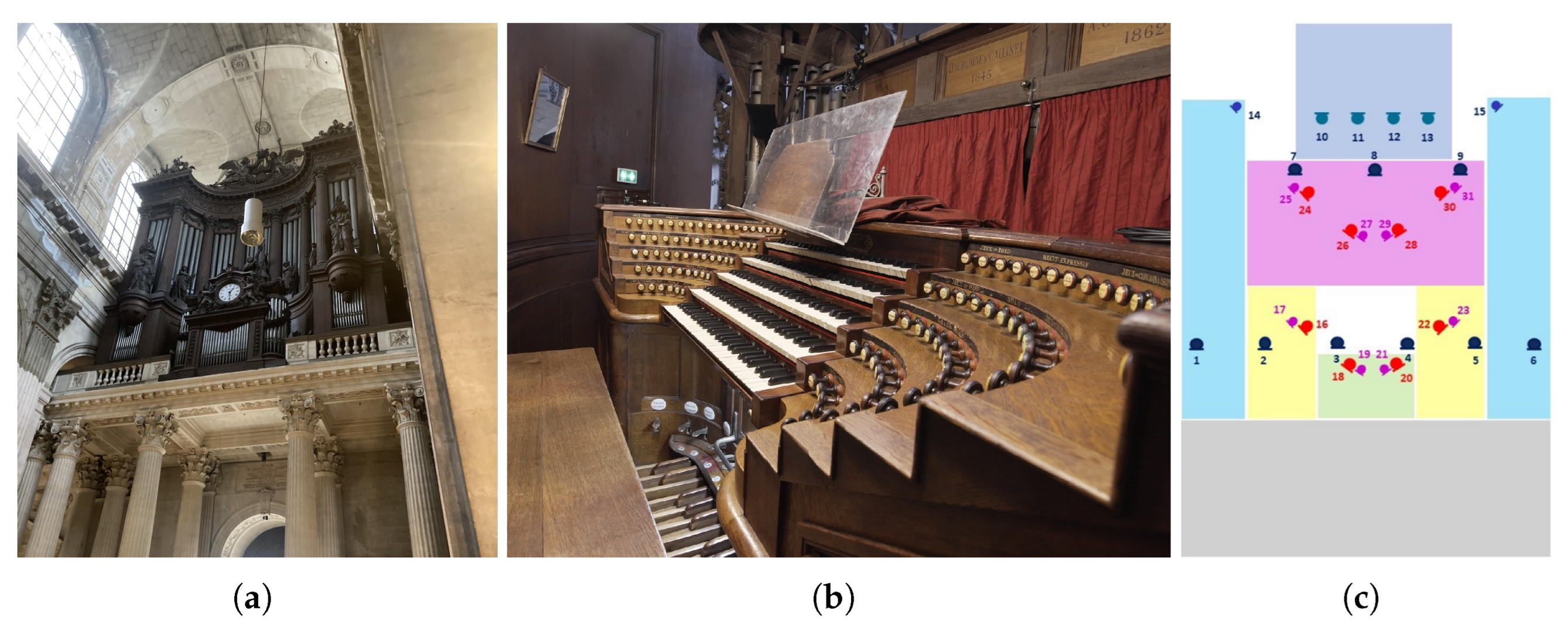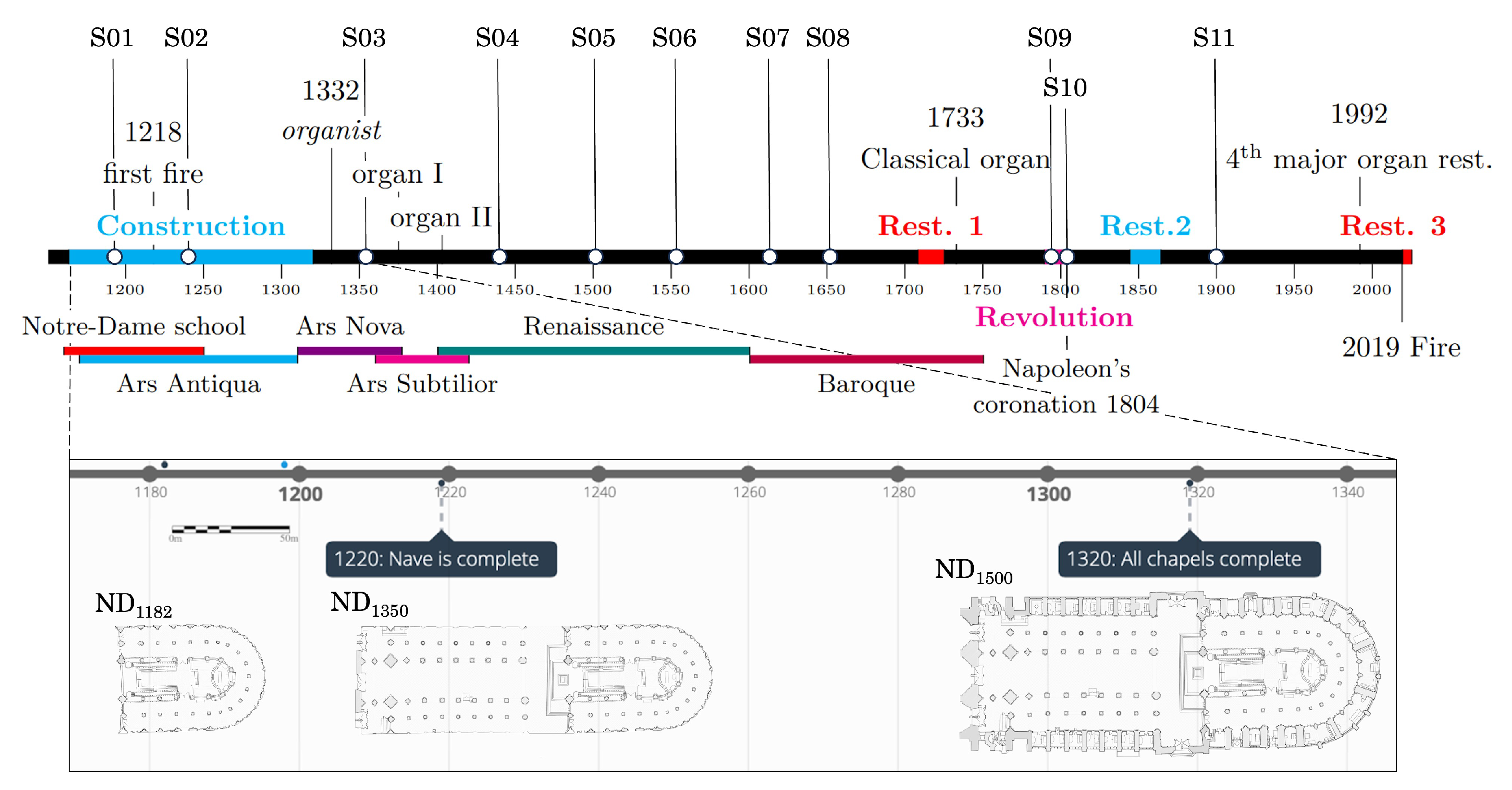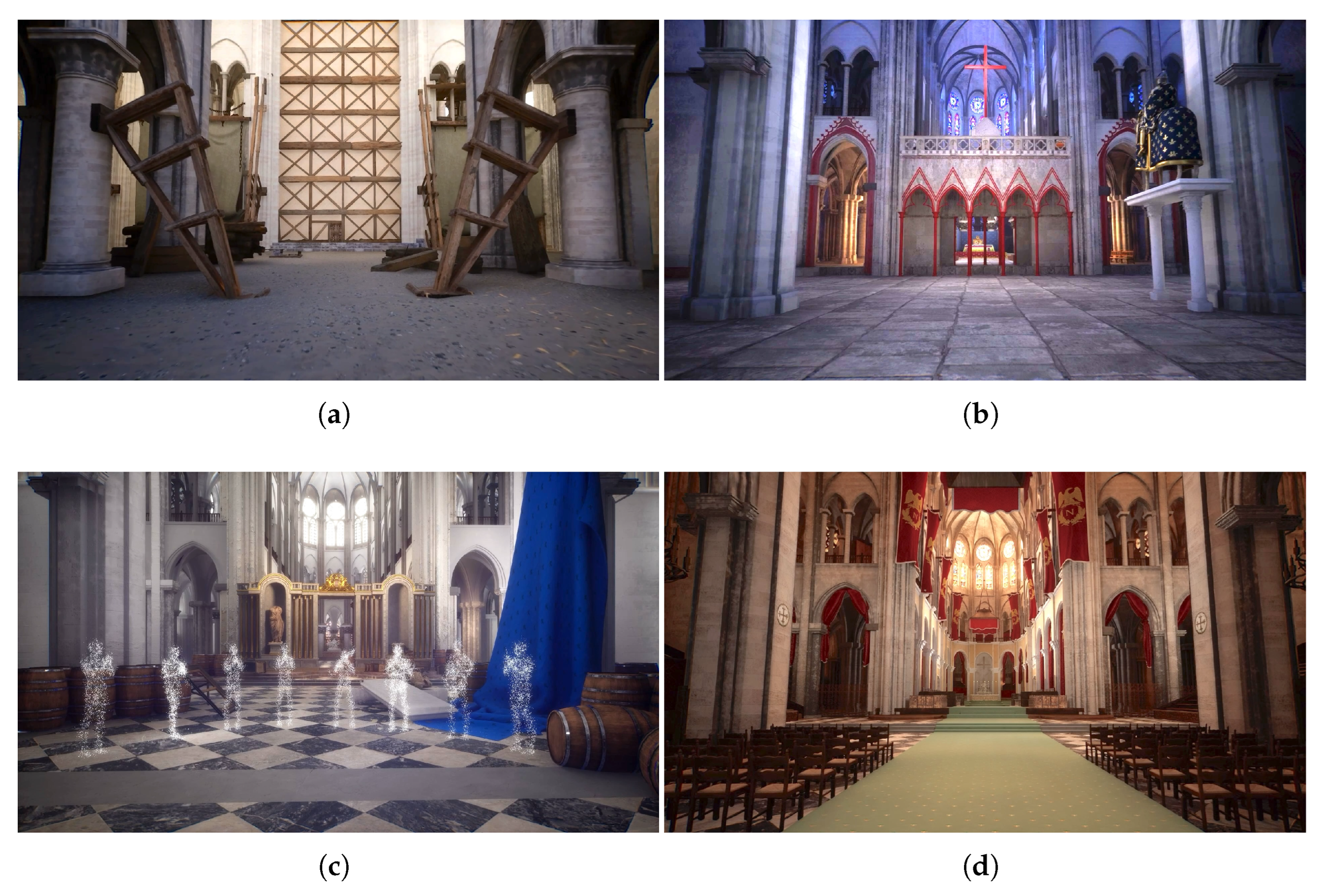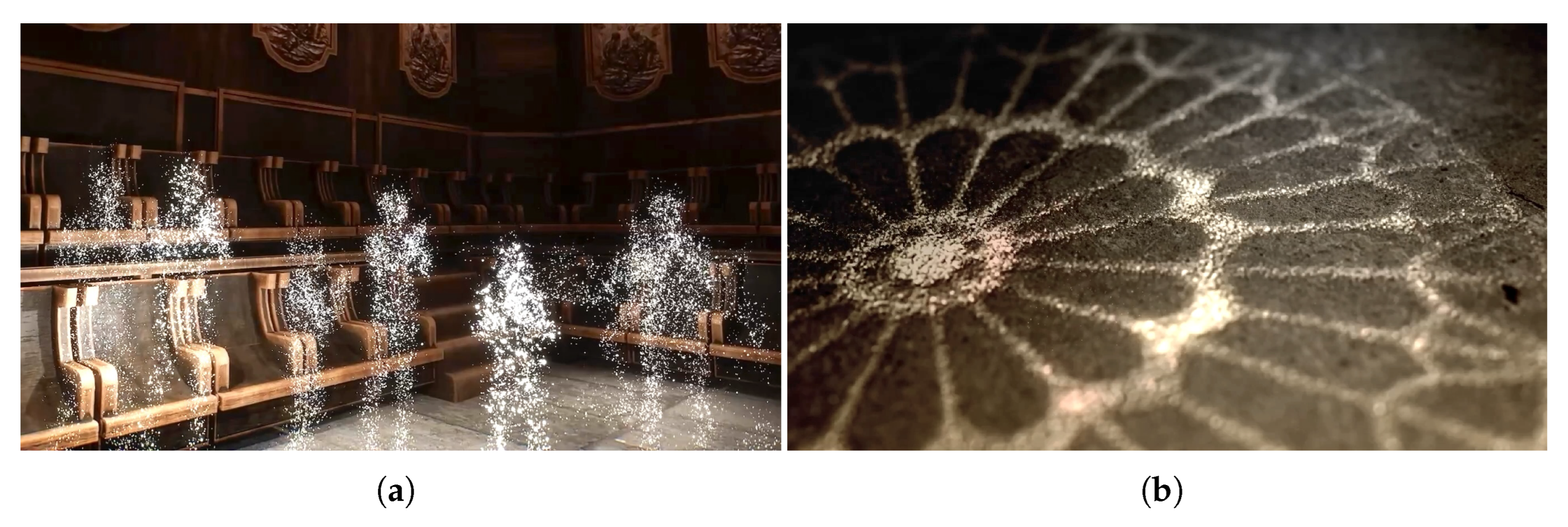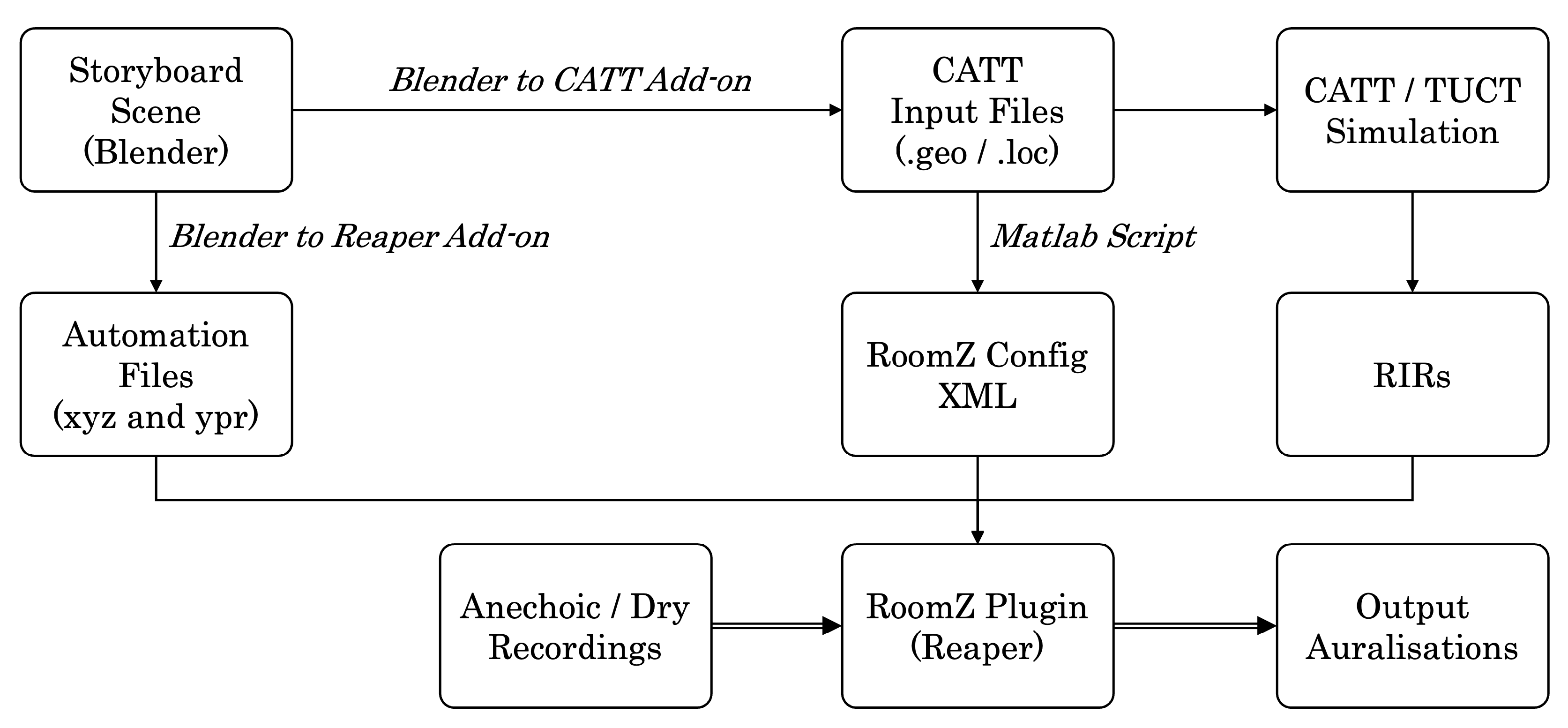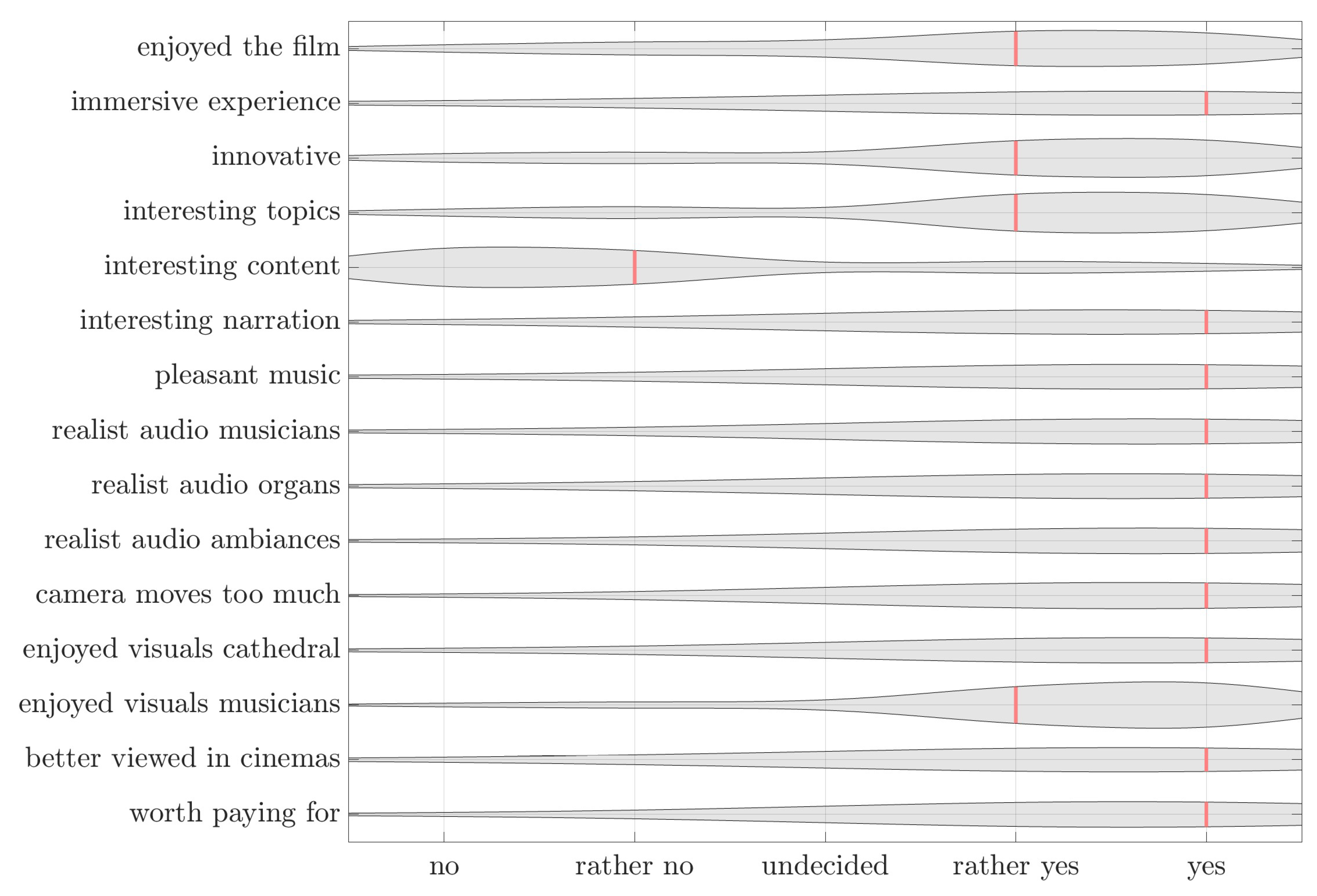1. Introduction
Archaeoacoustics examines how past societies utilised and experienced sound. This field encompasses studies of the acoustics of ancient sites such as caves, theatres, or cathedrals, historical musical instruments, and the influence of sound on rituals and communication [
1]. It integrates methodologies from archaeology, acoustics, and anthropology with advanced technologies like 3D scanning and acoustic simulations to better understand how sound shaped past human experiences.
The
Past Has Ears at Notre-Dame (ANR-PHEND) is a research project (2020–2025), applying archaeoacoustics to study how the evolution of the Notre-Dame de Paris Cathedral’s architecture and acoustics influenced its sonic history [
2]. Researchers of the PHEND project for example examined the impact of organ placements in the late medieval Notre-Dame on sound audibility and clarity [
3], or studied how wave-based simulations could be used to simulate the diffraction of its columns and piers compared to scale model measurements [
4]. PHEND is an extension of
the Past Has Ears (EU-PHE), a larger European project examining room acoustics as cultural heritage focusing on three major historical edifices in Europe [
5].
The
Vaulted Harmonies animated film is part of the scientific outreach effort of the PHEND project. It was designed to provide an intuitive and immersive experience of how the Notre-Dame de Paris Cathedral and its music evolved from its creation to the modern day. The following sections describe the steps involved in creating this film, available in both French and English on the film’s website [
6]. The film poster and a photograph from the pre-premiere working session are presented in
Figure 1.
The structure of this paper is as follows.
Section 2 reviews the state-of-the-art techniques employed in the making of the film and outlines previous archaeoacoustic research projects.
Section 3 introduces the musical pieces performed during the concert, along with their historical and musical context.
Section 4 describes the recording process for each piece.
Section 5 and
Section 6 detail the development of the acoustic and visual models of Notre-Dame, respectively.
Section 7 explains the workflow for creating the storyboard, which served as a reference for both acoustic and visual rendering teams.
Section 8 presents the auralisation process, whereby recorded musicians are projected into the simulated acoustics of the cathedral.
Section 9 outlines the post-production and distribution process, including adaptation to various audio and video formats. Finally,
Section 10 reports on audience feedback from the film’s premiere.
2. State of the Art
2.1. Auralisations
Vaulted Harmonies production relied on room impulse response (RIR) convolutions to create six degrees of freedom (6-DoF)
auralisations [
7]. Auralisation is a method which consists in recording or simulating the acoustics of a place, to then re-create a virtual listening experience in said place [
7]. 6-DoF indicates that the auralisation supports both user head rotation (3-DoF) as well as translation. Using 3-DoF auralisation based on binaural RIRs, Brinkmann et al. [
8] reported that this technique could be used to create
authentic virtual sound sources, i.e., indistinguishable from real ones [
9]. Arend et al. [
10] further reported that using interpolation between neighbouring RIRs, one could create
plausible auralisations supporting user translations as well as head rotations. Easier to achieve than authenticity, plausibility indicates that a simulation is in agreement with the listener’s expectation towards an equivalent real acoustic event [
11]. As highlighted in both studies, there is still some improvement required to systematise authentic auralisations, e.g., regarding the interpolation technique [
12,
13], the binaural to ambisonic shift required to simplify head rotation support [
13,
14], and the individualisation of renderings [
15]. Despite those limitations, RIR convolution is, as of today, one of the best solutions to create plausible room acoustic auralisations.
Compared to those studies, Vaulted Harmonies relies on simulated RIRs for auralisation. Such simulations mainly rely on two elements: an acoustic solver and a calibrated acoustic model. Two main families of solvers have been developed, based on either geometrical or wave based acoustics [
16]. The RIRs used for this film have been generated using the former, faster than its counterpart at the expense of imprecisions in the lower part of the spectrum [
17]. The most usual methodology to create a mesh on which to apply that solver usually starts with on-site measurements, resulting in a rough base model. Calibrating this model, so that its acoustic parameters [
18] conform to the parameters measured on-site within a pre-determined range of error, generally entails iterative adjustments to the model geometry, acoustic material properties, and solver simulation settings [
19,
20,
21,
22]. The quality of the simulation is then further validated through perceptive evaluations, characterising the authenticity of the resulting auralisations [
11,
23].
2.2. Archaeoacoustics
As the creation of these
digital acoustic twins became less of a challenge, researchers investigated how they could be used to recreate the acoustics of bygone edifices. In the case of buildings that are still standing, the process entails to retro-fit an acoustic model, calibrated to the existing building, to reflect the changes corresponding to an older version of that building. The methods developed heavily rely on archival work, systematically listing and documenting the architectural and furnishing changes that correspond to the studied version of a building [
1]. Boren [
24] documents how this process was conducted to simulate the changes in acoustics of a church between 1539 and 1723, to study the impact of room acoustics on J.S. Bach’s compositions. A similar process is detailed by Mullins [
25], applied to recreate five acoustic states of the Notre-Dame de Paris Cathedral from 1163 to 1500. Used in the current production, these models have been derived from the modern day cathedral model [
26], using a blend of archive documentation, comparative architecture with contemporary buildings, and measurements conducted on old furnishings of the cathedral preserved at the French Mobilier National museum.
Recreating plausible acoustics only solves half of the auralisation problem however. It is generally desirable to place some audio sources in these acoustic reconstructions. Ideally, said sources would be recorded in anechoic conditions, to prevent comb filtering or “room in a room” artefacts [
7]. In 2009, Lokki and Pätynen [
27] investigated design choices in their recording setup to achieve plausible auralisations of an orchestra. In that study, they discuss how microphones should be positioned to preserve the impact of the radiation pattern of various instruments across frequency bands [
28,
29], and which techniques can be used to reduce crosstalk between microphones during ensembles recordings, as they often result in spatially blurred auralisations [
30]. To record large instruments such as the organs of Notre-Dame, techniques based on arrays of proximity microphones have been developed to capture the spectral nuances of their multiple registers [
31,
32]. In that study, the authors further discuss how carefully designed multi-sources auralisations can be created to ensure perceptually accurate renditions of the width and breadth of such instrument.
As for acoustic simulations, researchers strive to ensure the authenticity of musical pieces used in archaeoacoustics studies. This means interpreting the score, if any, as it would have by musicians of the era under study. This also means using musical instruments identical to, or at least resembling those used back in the days [
33]. The methodology of what is referred to as
historically informed performances shares the same limitations as the one used for retro-fitting acoustic models, relying part on archives and musicological rationalisation, part on speculations [
25,
34,
35]. Still, scientists agree that these performances can provide useful insights into previous music cultures and are a precious resource to address questions related to acoustic and cultural heritage [
25]. The notion of acoustic heritage, central to Vaulted Harmonies, is further discussed by Zhu et al. [
36] as a form of cultural heritage that (a) encompasses acoustics or sounds worthy of preservation and reconstruction, (b) holds historical value in itself or in relation to its environment, and (c) embodies socio-cultural dimensions such as environments, people, and activities.
2.3. Preceding Works
In line with the film’s ambition, numerous projects have been carried out that incorporate some or all of the elements discussed so far, enabling users to experience past and present scenes, architecture, and acoustics first-hand [
37,
38,
39,
40,
41,
42,
43,
44,
45]. Researchers of the
AURA project for example created virtual concerts in three emblematic European concert halls and theatres: the Berlin Konzerthaus, the Teatro del Maggio Musicale Fiorentino and the Lviv Opera and Ballet Theater [
46]. Their virtualisations relied on LiDAR and photogrammetry measurements, adjusting the properties of the acoustical models from on-site surveys. Focusing on the interaction between acoustics and interpretation, researchers of the
Virtual Haydn project recorded pianists, performing live in virtual acoustic recreations of nine rooms in which Haydn either composed or performed [
47]. They also questioned the interaction between the musician and its instrument, repeating the performance on seven historical keyboards, likewise related to the composer’s career.
Vaulted Harmonies builds upon the foundations of the
Ghost Orchestra, a 2015 project that virtualised one of the concerts organised for the 850th anniversary of Notre-Dame de Paris [
26]. Leveraging simulated second-order ambisonic RIRs and 6-DoF auralisations, Ghost Orchestra projected more than 200 musicians, close-mic recorded live during the concert, into a calibrated model of the modern cathedral. The project was released as both a virtual reality (VR) desktop application and a five-minute online
video, enabling users to explore the space and perceive how the acoustics change with position and shape the musical experience. Vaulted Harmonies aspires to push the boundaries of such immersive productions. In addition to advancements in recording techniques, simulation scope, and both visual and acoustic resolution, this 66-min film aims to interweave science, musicology, and history into a compelling and immersive narrative of the cathedral’s heritage.
3. Selecting Key Periods and Musical Pieces
Multiple criteria guided the selection of the concert’s musical pieces, carried out in collaboration with the musicologists of the PHEND project. Some works are foundational to the cathedral’s musicological heritage, while others represent musical movements associated with specific liturgical periods. Certain pieces were chosen for their connection to historical events that shaped Notre-Dame’s past; others were composed for, or originally performed on, one of its iconic organs. The final selection includes six vocal works, one orchestral piece, and four organ pieces, each illustrating a different historical instrument associated with the cathedral.
3.1. Scene 01 Léonin, Organum Iudea et Ierusalem (7 Singers), Léonin (1150–1210)
In the 12th century, the construction of the new Gothic Cathedral of Notre-Dame de Paris began. It symbolised both Paris’s growing political influence in France, and the Church’s central role in medieval life. Léonin was one of the first known composer of polyphony, likely contributing to the Magnus liber organi, a landmark in notated music from the École de Notre-Dame musical movement. Iudea et Ierusalem is an example of early organum, where a plainchant is ornamented with elaborate organal voice melodies. This piece contributed to the birth of rhythmic and harmonic complexity in sacred music.
3.2. Scene 02 Pérotin, Viderunt Omnes (7 Singers), Pérotin (1160–1230)
By the early 13th century, Notre-Dame’s nave and towers were rising. Pérotin, seen as Léonin’s successor, continued and expanded his work on polyphony and liturgical music. He composed Viderunt Omnes for four voices, using the descant form adding counterpoints to the plainchant and organal voices. Its rhythmic precision and vertical harmony mark a turning point in Western composition. Pérotin’s music was uniquely shaped by, and designed for, Notre-Dame’s reverberant architecture.
3.3. Scene 03 Vitry, Adesto (Organ), Philippe de Vitry (1291–1361)
In the 14th century, as Notre-Dame’s structure was largely completed, France faced the instability of the Hundred Years’ War and the papal schism. Philippe de Vitry, bishop and theorist, shaped the Ars Nova, which revolutionised notation and rhythmic complexity. Adesto reflects this new style, balancing expressive clarity with intellectual structure. Though not written for Notre-Dame, it embodies the evolving sophistication of sacred music. It is interpreted in the concert on the first large organ of Notre-Dame, installed in the nave around 1360.
3.4. Scene 04 Frye, Ave Regina Caelorum (Organ), Walter Frye (?–1474)
In the 15th century, France was recovering from war and restoring institutions, including religious life at Notre-Dame. Walter Frye, an English composer whose music circulated widely in France, contributed to the smoother textures of the international polyphonic style. His Ave Regina Caelorum showcases serene, flowing vocal lines and a deeply devotional character. Its presence in French manuscripts reflects Notre-Dame’s ongoing role in absorbing and reflecting continental musical currents. It is interpreted on the second gothic organ of the cathedral, installed in 1403, positioned on the west gallery like the current organ.
3.5. Scene 05 Brumel, Ave Maria Gratia Dei Plena (10 singers), Antoine Brumel (1460–1515)
During the early Renaissance, Notre-Dame remained a key religious landmark while Paris regained its cultural prominence under the Valois kings. Brumel, originally chief singer of the Chartres Cathedral, was responsible for the musical education of the children at Notre- Dame de Paris between 1498 and 1500. He was one of the first to compose polyphony for larger choral forces with striking textural clarity. Ave Maria Gratia Dei Plena is a luminous Marian motet, reflecting the shift towards more homogenous, expressive polyphony resonating in large ecclesiastical spaces.
3.6. Scene 06 Sohier, Kyrie de la Missa Vidi Speciosam (16 singers), Mathieu Sohier (1500–1560)
In the 16th century, France experienced religious turmoil and the early Reformation. Notre-Dame however retained its Catholic identity and musical traditions. Mathieu Sohier, director of the choir school of the cathedral from 1533 to 1548, composed music directly for its liturgy. His Kyrie demonstrates the integration of Franco-Flemish style with the ceremonial needs of Notre-Dame. It illustrates how Renaissance polyphony adapted to the cathedral’s acoustic and ritual environment.
3.7. Scene 07 Racquet, Fantaisie (Organ), Charles Racquet (1597–1664)
Under Louis XIII, the 17th century brought Baroque grandeur and centralised royal power, with Notre-Dame remaining a symbolic stronghold of Catholic France. Charles Racquet served as organist at Notre-Dame from 1618 to 1643, composing the earliest surviving French organ fantasia. He was responsible for the evolution of the cathedral’s organ design, now boasting three keyboards, 2000 pipes and a positif built in front of the gallery. His Fantaisie explores contrapuntal virtuosity and the organ’s expressive potential within the cathedral’s acoustic. It signals the rise of instrumental music rooted in liturgical practice.
3.8. Scene 08 Frémart, Credo de la Missa Eripe me Domine (16 Singers, Positive Organ, Viola da Gamba), Henri Frémart (1595–1651)
As Baroque tastes matured, Notre-Dame continued to commission elaborate sacred music, despite political upheavals like the Thirty Years’ War. Frémart, appointed musical director for the choirboys of Notre-Dame de Paris in 1625, wrote for its specific acoustic and ceremonial functions. His Credo for five voices, published in 1643, combines clarity of text with rich harmonic language, adapted for liturgical grandeur. The piece typifies how composers tailored sacred polyphony to the grandeur of Notre-Dame’s liturgy and space.
3.9. Scene 09 Gossec, Hymne à la Liberté (5 Singers, Clarinet, Sackbut, Serpent), François-Joseph Gossec (1734–1829)
During the French Revolution, Notre-Dame was secularised and briefly renamed the “Temple of Reason”. Gossec, student of Rameau and official musician of the Revolution, composed works for civic ceremonies that redefined sacred spaces. This 1792 Hymne à la Liberté replaces religious devotion with nationalistic fervour. It arguably captures a moment when music and politics reshaped the cathedral’s meaning.
3.10. Scene 10 Lesueur, Ouverture de la Marche du Sacre (Orchestra, 48 Musicians), Jean-François Lesueur (1760–1837)
Following the Revolution, Notre-Dame was restored for Napoleon’s coronation in 1804, symbolising a return to imperial grandeur. Jean-François Lesueur, a prominent composer of the era and Master of the Chapel at the Tuileries since 1804, created music that blended classical forms with theatrical spectacle. His Ouverture de la Marche du Sacre embodies this synthesis, highlighting the cathedral’s role in legitimising political authority. The work’s success elevated Lesueur to the positions of Court Composer, conductor at the Opéra, and eventually professor at the Conservatoire, where he became Hector Berlioz’s teacher.
3.11. Scene 11 Vierne, Carillon de Westminster (Organ), Louis Vierne (1870–1937)
In the early 20th century, Notre-Dame’s organ tradition reached new heights under Louis Vierne, who served as titular organist for 37 years. Despite personal hardships, Vierne composed works that responded intimately to the cathedral’s acoustics and spiritual atmosphere. One such piece, Carillon de Westminster, inspired by the famous English chime, is a striking example of organ music that is both deeply personal and monumentally expressive. It is performed on the cathedral’s grand symphonic organ, built in 1867 and comprising more than 5000 pipes. Vierne notably performed this piece at the inauguration of the organ’s restoration in 1932.
4. Audio Recordings
Depending on the number of musicians and the size of their instruments, recordings were carried out under varying conditions. Regardless of these constraints, the objective remained consistent: to capture musically expressive interpretations with minimal room reverberation and as little microphone cross-talk as possible. Ensembles of fewer than 10 musicians were recorded in the anechoic chamber at Sorbonne University’s Jussieu campus, offering a floor area of 42
and a total volume of 240
. Larger ensembles were recorded either in the acoustically dry
Tarrazi studio or in the
Vincent Meyer Grand Plateau d’Orchestre at the Conservatoire de Paris (CNSMDP). Organ pieces were recorded using close-miking techniques in churches and amphitheatres where the facsimile and historical instruments were installed. In total, eight recording sessions were conducted, involving over 100 musicians and yielding 187 audio tracks. To make the anechoic recordings feel more natural, open-back headphones delivering real-time auralisations of the cathedral’s acoustics corresponding to the piece being performed [
43] were made available to the musicians.
4.1. Scene 01 Léonin and Scene 02 Pérotin, Anechoic Room, Jussieu, Paris
As illustrated in
Figure 2, each of the seven singers in the ensemble was equipped with a proximity microphone (DPA 4088). The microphones were mounted on headsets to maintain a constant distance from the singers’ mouths. This close positioning, combined with the microphones’ cardioid directivity, helped minimise cross-talk between singers, who were spaced
apart.
4.2. Scene 09 Gossec, Anechoic Room, Jussieu, Paris
The five singers of this ensemble, shown in
Figure 3, were equipped with the same proximity microphones. The clarinet, serpent and trombone were recorded using two microphones each: one mounted directly on the instrument (DPA 4099) and another placed approximately
away on a stand (Neumann KM140, TLM 170, KM 140). These support microphones were later used for timbre adjustments during the mixing process, before the auralisation.
4.3. Scene 05 Brumel, Scene 06 Sohier and Scene 08 Frémart, Tarrazi Studio, CNSMDP, Paris
Shown in
Figure 4, the Tarrazi studio is a 813
room with 159
of floor area, divided in half and acoustically treated with carpets, Texaa panels, and velvet curtains to reduce reverberation. As before, singers were equipped with headset-mounted cardioid microphones (DPA 4088) to minimise cross-talk. In Frémart’s piece, the continuo consisted of a positive organ and a viola da gamba. The viola da gamba was recorded using two cardioid microphones (Schoeps MK4V). The organ was surrounded by acoustic panels to limit bleed and was with three cardioid microphones (Neumann KM 184).
4.4. Scene 10 Lesueur, Grand Plateau d’Orchestre, CNSMDP, Paris
During the Lesueur recording session, each musician in the orchestra was equipped with a proximity microphone positioned 30
to 40
away from their instrument. The Timpani were recorded with two microphones, bringing the total to 49. Shown in
Figure 5, the Grand Plateau d’Orchestre has a floor area of 400
.
4.5. Scene 07 Racquet, Amphitheatre of Cité de la Musique, Paris
This recording took place in the amphitheatre of the Philharmonie de Paris, on the Jean-François Dupont organ built in 1995. Designed for 17th- and 18th-century repertoires, this Baroque organ offers a historically informed sound. As shown in
Figure 6, the recording employed 15 microphones with various polar patterns, positioned to balance the instrument’s different registers. The setup, and the routing of microphone signals to virtual sources used later in the auralisation, was informed by a preliminary study on pipe organ auralisation [
32].
4.6. Scene 03 Vitry and Scene 04 Frye, Éric Brottier Auditorium, Bouzy
The recordings of both De Virty and Fry pieces were performed on the organ in the auditorium of Éric Brottier in Bouzy, France. The instrument is a facsimile of a 1558 organ originally installed in Salamanca Cathedral, Spain. As shown in
Figure 7, an array of five cardioid microphones (DPA 4011c) was positioned in front of the organ façade. An additional five microphones were placed inside the instrument’s five partitioned compartments to allow for timbre adjustment during the auralisation.
4.7. Scene 11 Vierne, Church of Saint-Sulpice, Paris
This organ recording was made at Saint-Sulpice church. The 1862 Cavaillé-Coll organ installed there, comprising 7000 pipes, closely resembles the instrument at Notre-Dame as it existed when Vierne composed his Carillon de Westminster. As shown in
Figure 8, a total of 31 microphones were used for the recording. As in previous sessions, microphones were placed within the organ’s various compartments, and this setup was complemented by two additional arrays, one with six microphones and the other with three, positioned at different heights in front of the organ façade.
4.8. Narration, Anechoic Room, Jussieu, Paris
The narration scripts were written to briefly introduce the historical, architectural, and musical context of each piece. A voice actress recorded both French and English versions of the film using a headset microphone (DPA 4088) while standing 40 from a cardioid microphone (Neumann M149). Additional microphones were at distances of 40 , , and (two Neumann M149 and one Neumann U87), allowing for timbre adjustment in the mix, prior to final auralisation based on the intended distance between the narrator and the camera.
5. Acoustical Models
Four acoustic models were created to support the film’s auralisations, three of which are illustrated in
Figure 9, along with a timeline of the buildings construction and parallels in the evolution of musical style. The modern day model, referred to as ND
2015, was designed and calibrated as part of the Ghost Orchestra production mentioned previously. 3D laser scans of the interior of the cathedral were used to form the foundation of the geometric mesh. Then followed a calibration process to bring global and local parameters of
and
into an agreement of
just noticeable difference with on-site measurements for various source and receiver positions [
19,
23].
is a measure of the time it takes for the sound level in a room to decrease by 30 dB after the source of a sound has stopped, extrapolated to 60 dB. Musical clarity
is a measure of how sounds in a space blur into one another, calculated based on the ratio between the early sound energy to the later reverberant energy in a RIR, divided at 80
after the direct sound.
As discussed in
Section 2, the film’s auralisations were generated using geometrical acoustic simulations. This approach has known limitations, particularly in the lower frequency range where modal resonances that would naturally occur in the cathedral are not represented. This limitation is especially relevant for the three musical pieces featuring the organ, whose low-frequency content would have been strongly affected. A more extensive discussion of the limitations of this method for the auralisation of such monumental spaces in the context of music production is provided in Mullins [
25].
As detailed by Mullins [
25] , creating the ND
1500 model required only minor architectural modifications compared to ND
2015, such as the replacement of modern choir stalls and altars. However, its acoustics differed significantly due to the decorative elements and textile wrappings on the columns, which reflected how the cathedral was adorned during major festivals of the period. In ND
1350, the lateral chapels had not yet been constructed, which incrementally increased the reverberation time compared to the ND
1500 configuration. The space was also more sparsely decorated, further increasing its reverberation, bringing it closer acoustically to that of ND
2015.
For the ND
1182 model, the entire transept and nave were removed, as they had not yet been completed at the time. This resulted in a drastic change in the cathedral’s acoustics compared to the other three configurations. The
reverberation times from simulations using all four models are shown in
Figure 10, along with an example illustrating how much an acoustic parameter such as
can vary across different listening positions within the cathedral for a given source.
6. Visual Models and Animations
The creation of the visual models was based on the same archival research used for the acoustical models. The most striking transformation occurs between the ND
1182 and ND
1350 models, as the cathedral is opened to its newly completed nave and transept. More subtle architectural and material changes further affect how the cathedral looks and feels across different periods. As illustrated in
Figure 11, these include the evolution of the jubé (a liturgical screen or loft in medieval churches that separates the nave from the choir), the transition of the stone floor to the cathedral’s signature chequerboard pattern, and the temporary modification of the choir columns for Napoleon’s coronation.
The furnishing and decoration of the cathedral also change with each musical piece, reflecting the historical context of the period depicted. For example, broken statues, debris, and wine barrels are scattered throughout the cathedral to illustrate the impact of the French Revolution. For Napoleon’s coronation, the space is adorned with additional carpets, choir stalls, and textile wrappings on the columns (also incorporated in the acoustic model). Finally, each of the three organs has been modelled, textured, and integrated into the cathedral to represent the evolution of instrument-making practices.
Originally designed in Blender by the architecture restoration team (Sunmetron), the various components of the cathedral models were imported into Unreal Engine for texturing and lighting by the CGI team (Dada! Animation). The lighting was crafted to reflect different seasons and times of day, aiming—when possible—to match the likely ambiance in which each musical piece would have been performed. For example, Antoine Brumel’s Ave Maria is set between midnight and dawn, as it was reportedly sung during morning offices (Matins). Similarly, the lighting for Napoleon’s coronation seeks to recreate the early morning atmosphere of 2 December 1804.
Avatars of the musicians were integrated into the scenes as visual anchors for the auralisations. Initially intended as fully animated characters, they were ultimately designed as procedurally animated point clouds, a compromise between visual appeal and implementation complexity. The dry audio track of each musician was used to modulate the size and brightness of the point-cloud particles, effectively turning each avatar into a kind of dynamic level meter. The audio tracks were pre-processed using envelope detection, noise gating, logarithmic mapping, and compression to produce an automation track. The goal was to produce light and brightness variations that would “
naturally” follow the musical dynamics—without resembling stroboscopic Christmas lights. Despite its relative simplicity, this approach created a temporal and spatial coherent audiovisual experience that, ideally, enhances the readability of each scene. The final result is illustrated in
Figure 12a.
As shown in
Figure 12b, the visuals for the opening sequence were inspired by reference footage of Chladni figures. The concept was to evoke the distant resonance of Notre-Dame’s bells, gradually shaping piles of sand and pebbles into the form of the cathedral’s rose window.
The render resolution was 1920 × 1080 px, a compromise between visual quality and rendering time. The horizontal field of view was set to , a standard value for animated films. Preliminary tests suggested that, while minor audio-visual misalignments could occur, they remained subtle and generally unobtrusive when viewed from the middle rows of a typical movie theatre.
7. Storyboard and Cinematography
The film was designed to present subjective auralisations that align with the camera’s point of view. Several prototype scenes were developed to design camera animation paths that would support informed decisions when balancing the sometimes conflicting objectives of the project:
To create immersive and dynamic visuals that support the storytelling while showcasing details of the cathedrals,
To produce auralisations that enhance the music from ideal listening positions,
To illustrate how changes in listening position affect the acoustics of Notre-Dame and, consequently, the musical experience.
Built in Blender using mock-up meshes of the cathedral, these scenes were used to define the camera animation paths. At this stage, the positions of the musicians and organs were determined for each scene, as they naturally serve as primary focal points for the camera. Whenever possible, these positions were based on historical documentation about the cathedral and the relevant musical genres [
3]. The storyboard scenes were also used to feed an early version of the auralisation workflow, described in the next section, allowing for preliminary testing of the interaction between the music and the cathedral’s acoustics. Once finalised, the camera animation paths were exported, enabling the two teams, acoustic simulation and visual rendering, to work in parallel.
8. Dynamic Auralisations
This section details the steps of the auralisation workflow, as illustrated in
Figure 13.
8.1. Exporting Scene Graph Elements
The FBX exchange format was used to directly import camera animations and musician positions from the Blender storyboard scenes into Unreal Engine for visual rendering. Performing the same operation for acoustic simulation required the development of a custom Blender add-on [
48]. The add-on enabled the export of source positions in a format compatible with CATT-Acoustic. Its primary function was to sample the camera animation, simplifying the definition of discrete receiver positions set within CATT-Acoustic. The spatial sampling strategy was informed by a previous study on the effect of interpolations between RIRs in 6-DoF auralisations [
12].
8.2. Acoustic Simulations
The RIRs for each source-receiver pair were computed using a geometrical acoustics simulation software, CATT-Acoustic (v9.1) and TUCT (v2.0e:1.02). TUCT was configured with 1 × 10
6 rays and RIR lengths matching the
of each model, using algorithm 1 with first-order diffraction enabled. Simulations were distributed across five computers and ran for several weeks, resulting in a total of 34,181 third-order ambisonic RIRs. Depending on their size, the organs were modelled as clusters of 6 to 15 independent sources [
32]. Their directivity patterns were based on measurements taken from a facsimile scale model organ assembled in an anechoic room [
31]. Directivity patterns for the other instruments were defined using databases available through CATT-Acoustic’s directivity exchange or constructed from published data [
49]. Receivers were configured as 3rd-order ambisonic microphones.
8.3. RoomZ Configurations, Automations, Auralisations
The RoomZ audio plug-in [
50] was used to process the 6-DoF auralisations for the project within the audio workstation. RoomZ is essentially a partitioned convolution engine combined with an interpolation stage, capable of managing multiple source auralisations with a moving receiver, or conversely, a moving source with a fixed receiver. Depending on the scenario, interpolation is performed using either two or three neighbouring RIRs to ensure smooth transitions between discrete receiver positions.
A Matlab script was used to generate RoomZ configuration files from the acoustic simulation setup files [
51]. These XML files describe the scene, including available source and receiver positions, their associated RIRs, and a room image displayed in the plug-in UI to help visualise the auralisation layout. After importing the dry/anechoic recordings for each scene into Reaper, a configured RoomZ plug-in was added to each multichannel track to produce the auralisations. This multichannel setup allows a single set of automation parameters to control the listener’s position and orientation within the RoomZ scene.
A custom Blender add-on was developed to export Reaper automation curves from the camera animations in the storyboard scenes [
52]. The add-on samples the animation curve to create six automation files: three for Cartesian position coordinates and three for yaw, pitch, and roll orientations. Using a bounding box around the entire scene, the automation values are normalised to the [0:1] range to comply with the VST/VST3 standard used by RoomZ. Once imported into Reaper, the project is ready for the rendering stage, producing a third-order ambisonic auralisation for each of the eleven scenes.
To support the most demanding auralisations, such as that of the 26-source orchestra in Scene 10 Lesueur, a crop RIR preview feature was added to RoomZ. This feature allows users to truncate the RIRs both in time and ambisonic order to limit CPU usage, ensuring smooth real-time auralisations during prototyping sessions on casual laptops.
8.4. Additional Auralisations
Additional auralisations were created for the narration of each scene. Rendered in the acoustics of the current scene, the narration auralisations were static, designed more as a voice-over than as sound originating from a physical source.
Ambient sounds were recorded and added to the opening credits and the first scene of the film, which is set outside the 12th-century construction site of the cathedral. Recordings of the bells of Sens Cathedral, designed at the same period and in the same foundry as those of Notre-Dame, were used for the opening credits. The construction site ambiances were reconstructed using historical archives and recordings made at
Guédelon and
Montcornelles [
53], two experimental archaeology sites where a castle and a medieval village are being built using historically accurate techniques.
The auralisation of the construction site ambiances was created using both the IEM RoomEncoder [
54] and the Spat5 library [
55,
56]. Parametric reverberation and ambisonic encoding, much more flexible than simulated RIRs, were used in this case, as the opening credits and the construction site, being set outdoors, were not considered to require calibrated auralisations.
9. Post-Production and Distribution
There were two post-production stages: the first focused on the musical balance and authenticity of the auralisations, the second on adjusting the overall spectrum of the concert to the various distribution formats. To ensure authenticity, the sound engineers used reference recordings captured in situ during the recording sessions using omnidirectional, AB stereo, or binaural microphones. They adjusted the mix gains of the individual musicians prior to convolution so that the final auralisation, rendered at the reference microphone position, matched the balance of voices heard in the original recordings.
The second stage was, in practice, a series of sessions, each dedicated to a specific rendering format. For example, the creation of the Dolby Atmos DCP (Digital Cinema Package) for theatrical screenings required a half-day session in a licensed studio, during which low, mid, and high-frequency automation was progressively adjusted for the voices, orchestra and organ pieces.
To facilitate distribution, the ambisonic auralisation was decoded into a wide range of multichannel formats. Except for the DCP Dolby Atmos version, all the other formats were created using either Panoramix [
57] or Transpan [
58], both built on the Spat5 library. Transpan was used to generate the transaural version, intended for users on laptops and other 2.0 setups. Panoramix was used for all other multichannel exports (5.1, 7.1, 9.1, etc.), as well as the binaural version.
The binaural version was primarily created for viewers on online streaming platforms (Youtube, Vimeo, etc.), representing the majority of the concert’s audience. Careful attention was given to delivering a sharp and immersive spatial experience, despite the limitations of non-individualised rendering [
59]. Binaural decoding was performed using the head related transfer functions (HRTF) number 1032 from the LISTEN database [
60], selected because it was most frequently rated as the best by participants in previous perceptual HRTF evaluation studies [
61].
10. Audience Feedback from the Film’s Premiere
The premiere of Vaulted Harmonies took place at the Pathé Wepler cinema in Paris, presented in Dolby Atmos as part of UNESCO’s 2025 Sound Week. On this occasion, a two page questionnaire was distributed to the 174 spectators to gather feedback on the concert experience.
Participants had a mean age of years, with a gender distribution of 52% male and 48% female. 16% reported some degree of hearing loss without compensation, and 6% with compensation. Approximately half of the participants indicated that they regularly practice music and listen to musical content on surround sound systems. 30% reported frequently attending film screenings in Dolby Atmos. Finally, 37% were familiar with other immersive audio formats, such as ambisonic or binaural sound.
The results of the 15 multiple-choice questions from the questionnaire are presented in
Figure 14. Overall, participants reported a positive experience, describing the film as interesting, immersive, and well-suited to cinema setting. This result is interpreted with caution, as the nature of the event introduces a clear selection bias among participants. The audio was generally perceived as realistic, particularly in the reproduction of the musicians, organs, and ambient sounds. While most responses were favourable, some participants expressed mixed opinions about the visual rendering of the cathedral and the depiction of the musicians. When asked about their preferred acoustic rendering for the design of a second film, 85% of the participants favoured a dynamic and coherent perspective that follows the camera movements, while 15% preferred an idealised static listening position.
The questionnaire also included two open-ended questions. The first invited participants to identify the most striking fact they learned from the film. Among the responses, 22% referred to the cathedral’s organs and their historical significance, while 17% highlighted the secularisation of the cathedral during the French Revolution. Additionally, 14% mentioned the evolution of the architecture and acoustics, and 8% noted the development of musical practices over time.
The second open-ended question invited free-form comments. Among the most frequent suggestions, six participants recommended removing the auralisation applied to the narration, citing reduced intelligibility without clear immersive benefit. Four participants criticised the excessive camera movement, preferring more static shots. Another four suggested including a “behind the scenes” segment with images and videos from the production process.
11. Conclusions
The overall conception and production of this animated film represents a meaningful milestone in what can be achieved for scientific outreach in the fields of archaeoacoustics and virtual heritage. Looking ahead to other real/virtual hybrid productions, such as the 2019 live-action Lion King or Mandalorian series, a key improvement to the workflow would be the integration of real-time auralisation during the storyboard development. Additionally, a procedural animation system that generates visual performances based on audio tracks could significantly streamline the process of rendering performers or other sound-producing entities in the scene.
Vaulted Harmonies is set to be adapted for both VR and dome projection formats in the fall of 2025, a transition made feasible by its original design leveraging Unreal Engine and high-order ambisonics. The primary challenge for the VR version will be maintaining the resolution of both visuals and auralisations despite the software and hardware limitations of current consumer VR devices. For the dome version, the main challenges will include upscaling visual resolution, reimagining the cinematography to prevent cybersickness, and fully leveraging the field of view offered by dome theatres.
Author Contributions
The contributions below relate only to the writing of this manuscript, as the Vaulted Harmonies film is the result of many contributors beyond the three listed authors. Conceptualization, D.P.-Q., J.M. and B.F.G.K.; Data curation, D.P.-Q.; Formal analysis, D.P.-Q.; Funding acquisition, J.-M.L. and B.F.G.K.; Methodology, D.P.-Q. and B.F.G.K.; Project administration, J.-M.L. and B.F.G.K.; Resources, J.-M.L.; Software, D.P.-Q.; Supervision, D.P.-Q., J.M. and B.F.G.K.; Validation, J.-M.L. and B.F.G.K.; Visualization, J.M.; Writing—original draft, D.P.-Q.; Writing—review and editing, D.P.-Q., J.-M.L. and B.F.G.K. All authors have read and agreed to the published version of the manuscript.
Funding
Funding was provided in part by the French project PHEND (The Past Has Ears at Notre-Dame, Grant No. ANR-20-CE38-0014,
http://phend.pasthasears.eu, accessed on 13 October 2025). Additional funding provided by the SONICOM project (
http://www.sonicom.eu, accessed on 13 October 2025), European Union’s Horizon 2020 research and innovation program grant agreement No. 101017743.
Institutional Review Board Statement
Ethical review and approval were waived for this study due to its non-interventional nature, involving only voluntary participation in a film screening followed by an anonymous questionnaire about participants’ subjective impressions, with no collection of sensitive or identifiable data.
Informed Consent Statement
Informed consent was obtained from all subjects involved in the study.
Data Availability Statement
The data are available from the corresponding author on request.
Acknowledgments
We warmly thank all those who contributed to the creation of the film and concert presented in this study, including the musicians, sound engineers, acousticians, historians, musicologists, scientists, graphic designers, scriptwriters, and the staff of Notre-Dame de Paris. Their expertise and dedication made this project possible. For a complete list of contributors, please refer to the credits at the end of the film. This article is a revised and expanded version of a paper entitled “Virtual concert film with acoustic reconstructions of Notre-Dame de Paris across eight centuries”, which was presented on September 2025 at the 12th International Conference on Auditorium Acoustics in Bristol UK [
62].
Conflicts of Interest
The authors declare no conflicts of interest.
References
- Navas-Reascos, G.; Alonso-Valerdi, L.M.; Ibarra-Zarate, D.I. Archaeoacoustics around the world: A literature review (2016–2022). Appl. Sci. 2023, 13, 2361. [Google Scholar] [CrossRef]
- Katz, B.F.G.; Cros, C.; Peichert, S.; De Muynke, J. The Past Has Ears at Notre-Dame: Acoustic digital twins for research and narration. Digit. Appl. Archaeol. Cult. Herit. 2024, 34, e00369. [Google Scholar] [CrossRef]
- d’Alessandro, C.; Canfield-Dafilou, E.; Mullins, S.; Katz, B.F.G. The position of gothic organs in Notre-Dame de Paris: An archeoacoustic simulation study. Appl. Acoust. 2025, 231, 110506. [Google Scholar] [CrossRef]
- Weber, A.; Katz, B.F.G. Sound scattering by Gothic piers and columns of the Cathédrale Notre-Dame de Paris. Acoustics 2022, 4, 679–703. [Google Scholar] [CrossRef]
- Katz, B.F.G.; Murphy, D.; Farina, A. Exploring cultural heritage through acoustic digital reconstructions. Phys. Today 2020, 73, 32–37. [Google Scholar] [CrossRef]
- Vaulted Harmonies Website. Available online: https://vaultedharmonies.pasthasears.dalembert.upmc.fr (accessed on 13 October 2025).
- Vorländer, M. Auralization; Springer: Cham, Switzerland, 2020. [Google Scholar] [CrossRef]
- Brinkmann, F.; Lindau, A.; Weinzierl, S. On the authenticity of individual dynamic binaural synthesis. J. Acoust. Soc. Am. 2017, 142, 1784–1795. [Google Scholar] [CrossRef] [PubMed]
- Meyer-Kahlen, N.; Schlecht, S.; Garí, S.V.A.; Lokki, T. Testing auditory illusions in augmented reality: Plausibility, transfer-plausibility, and authenticity. J. Audio Eng. Soc. 2024, 72, 797–812. [Google Scholar] [CrossRef]
- Arend, J.M.; Garí, S.V.A.; Schissler, C.; Klein, F.; Robinson, P.W. Six-degrees-of-freedom parametric spatial audio based on one monaural room impulse response. J. Audio Eng. Soc. 2021, 69, 557–575. [Google Scholar] [CrossRef]
- Lindau, A.; Weinzierl, S. Assessing the plausibility of virtual acoustic environments. Acta Acust. United Acust. 2012, 98, 804–810. [Google Scholar] [CrossRef]
- De Muynke, J.; Poirier-Quinot, D.; Katz, B.F.G. Effect of interpolation artifacts on perceived stability of nearby sources in a navigable reverberant virtual environment. J. Audio Eng. Soc. 2024, 72, 664–678. [Google Scholar] [CrossRef]
- Müller, K.; Zotter, F. Auralization based on multi-perspective ambisonic room impulse responses. Acta Acust. 2020, 4, 25. [Google Scholar] [CrossRef]
- Werner, S.; Klein, F.; Neidhardt, A.; Sloma, U.; Schneiderwind, C.; Brandenburg, K. Creation of auditory augmented reality using a position-dynamic binaural synthesis system—Technical components, psychoacoustic needs, and perceptual evaluation. Appl. Sci. 2021, 11, 1150. [Google Scholar] [CrossRef]
- Engel, I.; Goodman, D.F.; Picinali, L. Assessing HRTF preprocessing methods for ambisonics rendering through perceptual models. Acta Acust. 2022, 6, 4. [Google Scholar] [CrossRef]
- Vorländer, M. Computer simulations in room acoustics: Concepts and uncertainties. J. Acoust. Soc. Am. 2013, 133, 1203–1213. [Google Scholar] [CrossRef] [PubMed]
- Kuttruff, H.; Vorländer, M. Room Acoustics; CRC Press: Boca Raton, FL, USA, 2024. [Google Scholar] [CrossRef]
- ISO 3382-1; Acoustics—Measurement of Room Acoustic Parameters—Part 1: Performance Spaces. International Organization for Standardization: Geneva, Switzerland, 2009.
- Postma, B.N.; Katz, B.F.G. Creation and calibration method of acoustical models for historic virtual reality auralizations. Virtual Real. 2015, 19, 161–180. [Google Scholar] [CrossRef]
- Pilch, A. Optimization-based method for the calibration of geometrical acoustic models. Appl. Acoust. 2020, 170, 107495. [Google Scholar] [CrossRef]
- Deetz, N.; Boren, B. Algorithmic methods for calibrating material absorption within geometric acoustic modeling. In Proceedings of the Audio Engineering Society Convention 153, New York, NY, USA, 19–20 October 2022; Audio Engineering Society: New York, NY, USA, 2022. Number 11. pp. 1–5. [Google Scholar]
- Bellows, S.D.; Katz, B.F.G. Constrained least-squares and maximum-likelihood calibration of absorption coefficients in reverberation time equations. Acta Acust. 2025, 9, 25. [Google Scholar] [CrossRef]
- Postma, B.N.; Katz, B.F.G. Perceptive and objective evaluation of calibrated room acoustic simulation auralizations. J. Acoust. Soc. Am. 2016, 140, 4326–4337. [Google Scholar] [CrossRef]
- Boren, B.B. Acoustic simulation of JS Bach’s Thomaskirche in 1723 and 1539. Acta Acust. 2021, 5, 14. [Google Scholar] [CrossRef]
- Mullins, S.M. Voices of the Past: The Historical Acoustics of Notre-Dame de Paris and Choral Polyphony. Ph.D. Thesis, Sorbonne Université, Paris, France, 2024. Available online: https://theses.hal.science/tel-04879114 (accessed on 13 October 2025).
- Postma, B.N.; Poirier-Quinot, D.; Meyer, J.; Katz, B.F.G. Virtual reality performance auralization in a calibrated model of Notre-Dame Cathedral. In Proceedings of the Euroregio Conference, Porto, Portugal, 13–15 June 2016; pp. 1–10. [Google Scholar]
- Lokki, T.; Pätynen, J. Applying anechoic recordings in auralization. In Proceedings of the EAA Symposium on Auralization, Espoo, Finland, 15–17 June 2009; pp. 15–17. [Google Scholar]
- Meyer, J. The sound of the orchestra. J. Audio Eng. Soc. 1993, 41, 203–213. [Google Scholar]
- Pätynen, J.; Lokki, T. Directivities of symphony orchestra instruments. Acta Acust. United Acust. 2010, 96, 138–167. [Google Scholar] [CrossRef]
- Katz, B.F.G.; Poirier-Quinot, D.; Lyzwa, J.M. La Vierge 2020: Reconstructing a virtual concert performance through historic auralisation of Notre-Dame Cathedral. In Proceedings of the Immersive and 3D Audio Conference: From Architecture to Automotive, Bologna, Italy, 8–10 September 2021; pp. 1–9. [Google Scholar] [CrossRef]
- Curulla, G.V.; Canfield-Dafilou, E.K.; Domenighini, P.; Fabre, B.; d’Alessandro, C.; Katz, B.F.G. Pipe organ buffet radiation patterns under different excitation strategies. In Proceedings of the 24th International Congress on Acoustics, Gyeongju, South Korea, 24–28 October 2022; pp. 1–8. [Google Scholar]
- Canfield-Dafilou, E.K.; Katz, B.F.G. Comparing virtual source configurations for pipe organ auralization. In Proceedings of the Audio Engineering Society Convention 155, New York, NY, USA, 25–27 October 2023; Audio Engineering Society: New York, NY, USA, 2023. Number 159. pp. 1–9. [Google Scholar]
- Eley, N.; Lavandier, C.; Psychoyou, T.; Katz, B.F.G. Listener perception of changes in historically informed performance of solo baroque music due to room acoustics. Acta Acust. 2024, 8, 6. [Google Scholar] [CrossRef]
- Leech-Wilkinson, D. Authentic to such a small degree that the word loses most of its intended meaning. Early Music 1984, 12, 13–16. [Google Scholar] [CrossRef]
- Taruskin, R. The authenticity movement can become a positivistic purgatory, literalistic and dehumanizing. Early Music 1984, 12, 3–12. [Google Scholar] [CrossRef]
- Zhu, X.; Oberman, T.; Aletta, F. Defining acoustical heritage: A qualitative approach based on expert interviews. Appl. Acoust. 2024, 216, 109754. [Google Scholar] [CrossRef]
- Hanussek, B. Ubisoft’s Notre-Dame: Digital gaming for material heritage’s sake. Loading 2024, 16, 1–15. [Google Scholar] [CrossRef]
- Rindel, J.H. The ERATO project and its contribution to our understanding of the acoustics of ancient theatres. In Proceedings of the Acoustics of Ancient Theatres Conference, Patras, Greece, 18–21 September 2011; pp. 18–21. [Google Scholar]
- Wall, J.N. Transforming the object of our study: The early modern sermon and the virtual Paul’s cross project. J. Digit. Humanit. 2014, 3, 3. [Google Scholar]
- Puget, J.; Pardoen, M.; Bouillot, N.; Durand, E.; Seta, M.; Bastien, P. Rapid prototyping of immersive video for popularization of historical knowledge. In Proceedings of the Thirteenth International Conference on Tangible, Embedded, and Embodied Interaction, Tempe, AZ, USA, 17–20 March 2019; pp. 197–203. [Google Scholar] [CrossRef]
- Rosseel, H.; van Waterschoot, T. A state-of-the-art review of acoustic preservation of historical worship spaces through auralization. Signal Process. 2025, 234, 109992. [Google Scholar] [CrossRef]
- De Muynke, J.; Ferrando, J.; Katz, B.F.G. A study on interpretation of medieval vocal repertoire through auralisation: An acoustic reconstruction of the great chapel of the Palais des Papes. Sound Stud. 2025, 11, 39–65. [Google Scholar] [CrossRef]
- Mullins, S.S.; Katz, B.F.G. Immersive auralisations for choral ensembles. In Proceedings of the 11th International Conference on Auditorium Acoustics, Athens, Greece, 28–30 September 2023; Volume 45, pp. 1–8. [Google Scholar]
- Vorländer, M. Virtual acoustics. Arch. Acoust. 2014, 39, 307–318. [Google Scholar] [CrossRef]
- Katz, B.F.G.; Barteld, N.; Poirier-Quinot, D. Virtual reconstructions of the Théâtre de l’Athénée for archeoacoustic study. In Proceedings of the International Congress on Acoustics, Aachen, Germany, 9–13 September 2019; pp. 303–310. [Google Scholar]
- Lumini, A.; Cioli, F. Project AURA: Acoustic simulation of theatre halls-from digital survey to virtual reconstruction. In Digital & Documentation—From Virtual Space to Information Database; Pavia University Press: Pavia, Italy, 2023; Volume 5, pp. 78–93. [Google Scholar]
- Woszczyk, W.; Beghin, T.; de Francisco, M.; Ko, D. Recording multichannel sound within virtual acoustics. In Proceedings of the Audio Engineering Society Convention 127, New York, NY, USA, 9–12 October 2009; Audio Engineering Society: New York, NY, USA, 2009. Number 7856. pp. 1–8. [Google Scholar]
- Blender Add-On for CATT-Acoustic. Available online: https://github.com/PyrApple/io_export_catt (accessed on 13 October 2025).
- Meyer, J. Acoustics and the Performance of Music: Manual for Acousticians, Audio Engineers, Musicians, Architects and Musical Instrument Makers, 5th ed.; Springer: New York, NY, USA, 2009. [Google Scholar] [CrossRef]
- Poirier-Quinot, D.; Stitt, P.; Katz, B.F.G. RoomZ: Spatial panning plugin for dynamic RIR convolution auralisations. In Proceedings of the Audio Engineering Society International Conference on Spatial and Immersive Audio, Huddersfield, UK, 23–25 August 2023; pp. 19:1–19:7. [Google Scholar]
- Matlab CATT Toolbox. Available online: https://github.com/PyrApple/catt-matlab-package (accessed on 13 October 2025).
- Blender Add-On for Reaper. Available online: https://github.com/PyrApple/io_export_reaper (accessed on 13 October 2025).
- Pardoen, M.; Guesney, M. Study and analysis of the sound environment of the Notre-Dame construction site between the 12th and 18th centuries. J. Cult. Herit. 2024, 65, 155–159. [Google Scholar] [CrossRef]
- IEM Plug-In Suite. Available online: https://plugins.iem.at (accessed on 13 October 2025).
- Carpentier, T. Spat∼: A comprehensive toolbox for sound spatialization in Max. Sonic Ideas 2021, 13, 12–23. [Google Scholar]
- Carpentier, T.; Noisternig, M.; Warusfel, O. Twenty years of Ircam Spat: Looking back, looking forward. In Proceedings of the 41st International Computer Music Conference, Denton, TX, USA, 25 September–1 October 2015; pp. 270–277. [Google Scholar]
- Carpentier, T. Panoramix: 3D mixing and post-production workstation. In Proceedings of the 42nd International Computer Music Conference, Utrecht, The Netherlands, 12–16 September 2016; pp. 122–127. [Google Scholar]
- Baskind, A.; Carpentier, T.; Noisternig, M.; Warusfel, O.; Lyzwa, J.M. Binaural and transaural spatialization techniques in multichannel 5.1 production. In Proceedings of the 27th Tonmeistertagung, VDT International Convention, Köln, Germany, 22–25 November 2012; pp. 1–9. [Google Scholar]
- Oehler, M.; Voong, T.M.; Regener, M.; da Costa, M.d.V.; Reuter, C. Importance of HRTF personalisation for audio rendering in music-related virtual environments. In Proceedings of the 10th Convention of the European Acoustics Association (Forum Acusticum), Torino, Italy, 11–15 September 2023. [Google Scholar]
- IRCAM Listen HRTF Database. Available online: http://recherche.ircam.fr/equipes/salles/listen (accessed on 13 October 2025).
- Katz, B.F.G.; Parseihian, G. Perceptually based head-related transfer function database optimization. J. Acoust. Soc. Am. 2012, 131, 99–105. [Google Scholar] [CrossRef]
- Poirier-Quinot, D.; Katz, B.F.G.; Lyzwa, J.M. Virtual concert film with acoustic reconstructions of Notre-Dame de Paris across eight centuries. In Proceedings of the 12th International Conference on Auditorium Acoustics, Bristol, UK, 8–10 September 2025; Institute of Acoustics: Milton Keynes, UK, 2025; Volume 47, pp. 1–8. [Google Scholar]
Figure 1.
(a) Vaulted Harmonies poster and (b) photograph from the pre-premiere working session.
Figure 1.
(a) Vaulted Harmonies poster and (b) photograph from the pre-premiere working session.
Figure 2.
(a) Singers in the anechoic room during the recordings of Scene 01 Léonin and Scene 02 Pérotin. (b) Singer equipped with a proximity microphone.
Figure 2.
(a) Singers in the anechoic room during the recordings of Scene 01 Léonin and Scene 02 Pérotin. (b) Singer equipped with a proximity microphone.
Figure 3.
(a) Musicians in the anechoic room during the recordings of Scene 09 Gossec. (b) Serpent and (c) Baroque clarinet players.
Figure 3.
(a) Musicians in the anechoic room during the recordings of Scene 09 Gossec. (b) Serpent and (c) Baroque clarinet players.
Figure 4.
(a) Musicians in the Tarrazi studio during the recordings of Scene 08 Frémart. (b) Viola da gamba and (c) positive organ players.
Figure 4.
(a) Musicians in the Tarrazi studio during the recordings of Scene 08 Frémart. (b) Viola da gamba and (c) positive organ players.
Figure 5.
(a) Musicians in the Grand Plateau d’Orchestre during the recordings of Scene 10 Lesueur. (b) Positions of the musicians and microphones during the recordings.
Figure 5.
(a) Musicians in the Grand Plateau d’Orchestre during the recordings of Scene 10 Lesueur. (b) Positions of the musicians and microphones during the recordings.
Figure 6.
(a) Organist during the recordings of Scene 07 Racquet. (b) Positions of the microphones during the recordings: blue dots indicate microphones positioned in front of the organ façade, the rest are positioned inside the instrument’s compartments.
Figure 6.
(a) Organist during the recordings of Scene 07 Racquet. (b) Positions of the microphones during the recordings: blue dots indicate microphones positioned in front of the organ façade, the rest are positioned inside the instrument’s compartments.
Figure 7.
(a) Organist during the recordings of Scene 03 Vitry and Scene 04 Frye. (b) Microphone array in front of the positive and (c) positions of the microphones during the recordings.
Figure 7.
(a) Organist during the recordings of Scene 03 Vitry and Scene 04 Frye. (b) Microphone array in front of the positive and (c) positions of the microphones during the recordings.
Figure 8.
(a) Façade of the Saint-Sulpice organ used during the recordings of Scene 11 Vierne. (b) Console of the organ and (c) positions of the microphones during the recordings.
Figure 8.
(a) Façade of the Saint-Sulpice organ used during the recordings of Scene 11 Vierne. (b) Console of the organ and (c) positions of the microphones during the recordings.
Figure 9.
Chronology of Notre-Dame construction, significant events of its history, and musical pieces of the concert (S01, S02, etc.).
Figure 9.
Chronology of Notre-Dame construction, significant events of its history, and musical pieces of the concert (S01, S02, etc.).
Figure 10.
(a) Variations of reverberation time () across the four acoustic models of Notre-Dame. (b) Variations of clarity () across listening positions in the ND1350 model for the swallow’s nest organ source position along the listener trajectory of Scene 03 Vitry.
Figure 10.
(a) Variations of reverberation time () across the four acoustic models of Notre-Dame. (b) Variations of clarity () across listening positions in the ND1350 model for the swallow’s nest organ source position along the listener trajectory of Scene 03 Vitry.
Figure 11.
Evolution of the visual model between (a) Scene 01 Léonin (ND1182) during construction of the nave, (b) Scene 03 Vitry (ND1350), (c) Scene 09 Gossec (ND2015), and (d) Scene 10 Lesueur (ND2015).
Figure 11.
Evolution of the visual model between (a) Scene 01 Léonin (ND1182) during construction of the nave, (b) Scene 03 Vitry (ND1350), (c) Scene 09 Gossec (ND2015), and (d) Scene 10 Lesueur (ND2015).
Figure 12.
(a) Avatars of the musicians, animated using individual audio tracks. (b) Animation of the opening sequence, inspired by Chladni patterns.
Figure 12.
(a) Avatars of the musicians, animated using individual audio tracks. (b) Animation of the opening sequence, inspired by Chladni patterns.
Figure 13.
Auralisation workflow.
Figure 13.
Auralisation workflow.
Figure 14.
Participant responses to the questionnaire administered after the film’s premiere. Red bars indicate median values.
Figure 14.
Participant responses to the questionnaire administered after the film’s premiere. Red bars indicate median values.
| Disclaimer/Publisher’s Note: The statements, opinions and data contained in all publications are solely those of the individual author(s) and contributor(s) and not of MDPI and/or the editor(s). MDPI and/or the editor(s) disclaim responsibility for any injury to people or property resulting from any ideas, methods, instructions or products referred to in the content. |
© 2025 by the authors. Licensee MDPI, Basel, Switzerland. This article is an open access article distributed under the terms and conditions of the Creative Commons Attribution (CC BY) license (https://creativecommons.org/licenses/by/4.0/).
